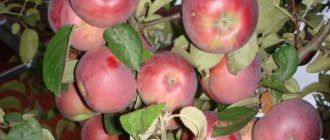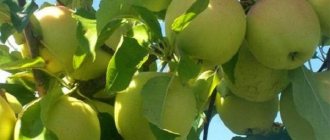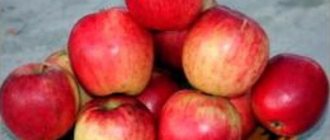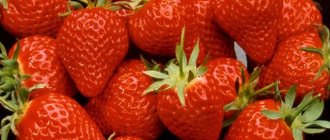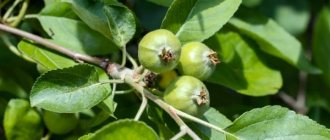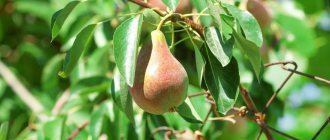There is a plot for a garden. And every gardener, when planning it, definitely wants to plant apple trees. There are also those who just want to plant an apple tree. He is not interested in the variety. So that they are tasty and that's it .
It's rare, but it happens. The majority are those who want early, middle and winter apples in the garden and on the table.
old traditional varieties well known for their delicious apples . But there are now enough new varieties. Many of them are even better – in taste and appearance. Yes, and for other qualities.
In fact. What does a gardener want from apples:
- So that they are large, beautiful and tasty.
- Their productivity was high and annual.
- So that they are not afraid of frost and disease.
- So that they do not spoil quickly, but are stored longer.
- And care should be easy . A lower tree is much more convenient than one 5-6 meters tall. Run under it then with the ladder.
- You also need to remember about the ability of the chosen variety to grow and bear fruit well in your place of residence.
Nowadays, the garden can be larger on low-growing rootstocks (dwarf and semi-dwarf) with 8-10 apple trees.
I will suggest an option:
- Early and late summer - 2-3.
- Autumn -2-3.
- Winter -4-6.
I will be glad if you agree with him.
Advice! If I have already suggested an option in terms of quantity, I dare to recommend the Orlinka apple tree among the summer-ripening varieties.
The Orlinka apple tree is characterized by high productivity.
Description
Let's get to know this apple tree:
- Year of birth: 1978.
- Place: All-Russian Research Institute for Selection of Fruit Crops. Orel city.
- The original varieties are Stark Erliost Precos and First Salute.
- Creators-authors – E.N. Sedov, Z.M. Serova, N.G. Krasova.
- Since 1991, it has already been in the State Register in the Central Black Earth region. You will meet its plantings in the Moscow region, Oryol, Perm, Kaliningrad, Vladimir regions. And this is not a complete list.
Tree:
- A vigorous tree with a spherical crown .
- Smooth, compact branches extend from the trunk at sharp angles.
- Dark gray and smooth bark .
- It bears fruit on ringlets and spears.
- In thick and rounded shoots, weak geniculation is barely noticeable.
- Matte-colored, elongated leaves have a twisted top and an elongated petiole.
- Large light pink flowers from large flower buds .
- Slightly flattened, round and medium in size fruit. Their weight is from 100 to 200 grams. But the bulk of the fruit is about 150 g. With shiny and smooth skin.
Fruits of the Orlinka apple tree.
- The greenish-yellow color quickly turns light yellow when picked. Painted with red stripes over most of the surface. Subcutaneous points are also noticeable.
- Aromatic sweet and sour taste of the pulp.
By the way! Experts often make comparisons with the Melba apple tree. We will do this too. Still, Melba is known to many.
Orlinka apple tree - description of the variety and its characteristics
Orlinka is a summer variety bred by crossing the American Stark Earlies Precos with the Russian First Salyut. The authors of Orlinka are E. Sedov, N. Krasova and Z. Serova. In 2001, the variety was included in the State Register, and at the same time it was zoned for the Central Black Earth region of our country.
Description of the tree
The description of the variety, as a rule, can begin with the description of the tree:
- the Orlinka tree is tall, with a rounded crown, sometimes reaching a height of 5 m;
- branches growing at an acute angle are powerful, with large round, pointed at the end, dark green leaves covered with fluff;
- The apple tree blooms profusely, covered with numerous large pale pink flowers. Flowering begins early - in early May;
- Orlinka is a self-fertile variety, however, for better pollination, it is necessary to plant other varieties of apple trees nearby. This species is perfectly pollinated by Moscow Grushovka, Oryol striped, Papirovka or Melba;
- the variety itself is also a wonderful pollinator for these and other types of crops.
Beginning of fruiting and yield
Apple trees of this variety produce the first apples already in the second year after planting, and by 4 years they begin to bear fruit in full force, producing from 20 to 40 kg of fruit. The highest yields with good care from a tree 10 years old are 140-160 kg per tree for the entire season.
Description of fruits
Orlinka fruits are medium and large - from 120 to 200 g. The shape of apples is round, slightly flattened. Color - yellow-green when ripe, changes to yellow. And after harvesting, the apples become covered with red stripes. Subcutaneous dots are observed on the surface.
The pulp is soft cream in color, dense, with large grains, juicy and aromatic, has a unique sweet, with some sourness, taste.
Read also: How a date palm blooms photo
100 g of pulp contains:
- sugar - 9.5%;
- acids - 0.8%;
- vitamin C - 6.7 mg;
- active substances - 314 mg.
According to a five-point system, the taste and appearance of the fruit are rated at 4.3 points.
Usage
Orlinka apples are eaten fresh. They also make excellent preserves and jams, jams and compotes. They are dried and baked, added to stuffing and fruit salads.
Transportability and storage
This variety of apples, like all summer crops, is stored for only a short time - a little more than a month at a temperature of +1 to +8 degrees. During this time, the fruits must either be eaten or processed. The variety does not tolerate long-distance transportation very well due to its short shelf life.
Ripening and harvesting dates
The Orlinka variety is early. The first apples begin to ripen in early August. The ripening process is uneven, that is, the apples do not ripen all at once, but in small batches, therefore, there are no specific harvest dates. The fruits are removed as they ripen.
Frost resistance and drought resistance
The variety is quite frost-resistant - can withstand frosts down to -35 °C. Orlinka also tolerates summer heat and drought well, provided that watering of the trees is increased. Plants of the variety are not afraid of temperature changes and climatic disasters.
additional characteristics
Advantages and disadvantages
Advantages:
- Very adapted to harsh conditions . He is among the leaders. Therefore, it is suitable for cultivation in many regions of Russia. It was created for them.
- Does not require any special care conditions.
- The apples are of very high quality – both in marketability and in taste.
- It is noted for its precociousness and high productivity.
Apples do not ripen on a tree at the same time. And sort of take turns. For the consumer, the pleasure is prolonged. This is considered a minor drawback. It's summer after all.
Tree height and crown width
Strong and tall trees with a round (spherical) dense crown.
When young, the branches are directed upward.
With the beginning of fruiting, they bend more towards the ground. Fruits also help.
Productivity
Quite decent for an early variety.
Even from young apple trees you can collect up to 25-30 kg per tree. And more. Let's not talk about yield per hectare.
Melba will give less. Or maybe you'll take less.
Tasting assessment
According to all indicators, they are rated 4.3 points out of five.
Take into account 9.5% sugar and acid.
Winter hardiness
Interesting fact. Not the strongest resistance to frost .
This is how experts characterize it. But it ensures that gardeners in Central Russia can successfully grow this early variety.
Disease resistance
In each region, disease resistance is quite satisfactory.
In the Oryol region (in their homeland) they are very resistant to scab.
But you won’t wait to see how the apple tree itself will resist disease.
Advice! Develop a small system for preventing illness and disease. And there will be no need to save from something in a fire emergency. It is not difficult.
Video Review
There is a plot for a garden. And every gardener, when planning it, definitely wants to plant apple trees. There are also those who just want to plant an apple tree. He is not interested in the variety. So that they are tasty and that's it .
It's rare, but it happens. The majority are those who want early, middle and winter apples in the garden and on the table.
old traditional varieties well known for their delicious apples . But there are now enough new varieties. Many of them are even better – in taste and appearance. Yes, and for other qualities.
In fact. What does a gardener want from apples:
- So that they are large, beautiful and tasty.
- Their productivity was high and annual.
- So that they are not afraid of frost and disease.
- So that they do not spoil quickly, but are stored longer.
- And care should be easy . A lower tree is much more convenient than one 5-6 meters tall. Run under it then with the ladder.
- You also need to remember about the ability of the chosen variety to grow and bear fruit well in your place of residence.
Read also: DIY Christmas angel craft
Nowadays, the garden can be larger on low-growing rootstocks (dwarf and semi-dwarf) with 8-10 apple trees.
I will suggest an option:
- Early and late summer - 2-3.
- Autumn -2-3.
- Winter -4-6.
I will be glad if you agree with him.
The Orlinka apple tree is characterized by high productivity.
Reviews
Anna. Vladimir. “The first fruiting of the Orlinka apple tree occurred 5 years after planting. We bought it after studying the description and photos. Delicious and early summer apples. I liked it. It’s too early to talk about productivity. The tree is still small, but it has produced a lot of apples. There was a lot of fall - summer ones. Or maybe a lot of ovary.”
Stepan. Kursk “I’m happy not only with the apples. Everything that was written about it when studying the photo and description of the variety corresponds. Even the fact that individual apples reach a weight of 210 grams.
A new scab-resistant apple variety from the All-Russian Research Institute for the Breeding of Fruit Crops with summer-ripening fruits. In a good season they are almost all the same size – large. It is better to remove them from the tree when they are yellowish - crispy, tasty, juicy. When they acquire an orange color, they are glassy-loose. Watery porridge. Don't let them fall off! Remove them for juice yourself, slightly unripe.”
Semyon Anatolyevich. Nizhny Novgorod. “It just so happened. But there are two early varieties of apple trees in the garden - Melba and Orlinka. So you have to compare all the time. Both are good. But I still like Orlinka more. To me. My wife has a slightly different opinion. She prefers Melba. Almost simultaneously they matured.
We filmed Orlinka before. A good harvest added to the troubles. There are already enough of them at this time. Treated. We even managed to sell something. They took it away right away. Just don’t let it fall!”
Features of planting and care
Landing
Deadlines
Life doesn't always work out the way you would like. Same with planting dates. You definitely can’t write them down. Even if they try. And they make up gardener’s lunar calendars.
Advice! One amateur gardener I know said: “For me, the best lunar calendar is suitable weather and a non-working day.”
The main thing is that these are acceptable and suitable conditions :
- Weather and soil conditions.
- Readiness and availability of seedlings.
- And follow the principles and rules of planting an apple tree.
But still:
- As with most early varieties, preference is given to planting in the spring: Second half of April, early May.
- After the leaves fall and 25-30 days before the onset of frost. Not even frost, but real cold.
Technology
- Choose a suitable place and soil : Sunny areas are very comfortable for this variety.
- If there are slopes, then they are southern.
- Loamy, loose, light soils.
- Think about drainage too.
There are no special features when landing.
- The planting method and sequence is usual : Prepare a planting hole of the required size (up to 60 cm deep and up to a meter in diameter). Taking into account the root system of the seedling: In advance (gardeners advise).
- Fill it with fertile soil with fertilizers, compost and ash.
- Place the seedling on the prepared mound, evenly distributing the roots.
Correct planting technology
Watch out for grafting! It should be 5-8 cm higher above the ground and when the soil shrinks.
Distance
It will depend on what rootstock the seedlings are on and what crown shapes you choose .
And it will be:
- With a vigorous rootstock - 4.5-5.0 m between rows and 3.5-4.0 m in a row.
- With semi-dwarf - 4.0 m and 3.0 m.
- With dwarf - 3.0-3.5 m and 2.0-2.5 m.
Recommended landing distances.
Features of cultivation
- Note. No special features .
- Water regularly. Especially after planting in spring: More often in hot weather. But in the evening.
- Under the root with watering.
Agricultural technology
Includes a set of measures for caring for an apple tree. Some of them have already been considered.
Pay attention to pest control . There are plenty of people who like to feast on your work - more than 30 (sucking, gnawing, etc.).
When is it more effective:
- Treatment of wintering stages of pests (February - March): copper sulfate and preparation 30B, DNOC, Khom and fufanon.
- April-May - before flowering: Aktara, Enzhio, Urea, Nitrafen.
- June-August - 2-3 times, during the formation of the ovary and fruits: Aktara, Preparation 30B.
- October-November – after harvesting the fruits and falling leaves: Urea, Fufanon, Iron sulfate.
Apply insecticides:
- Chemical.
- Biological.
Advice! Don't forget about folk remedies.
Pruning and crown formation
They are mandatory techniques.
Pollinator varieties
For many apple trees, this variety is an indispensable pollinator.
This should be planted next to Orlinka:
- Padding,
- Melbu,
- Moscow Grushovka.
It will help them by providing better pollination. And she herself doesn’t seem to need others. But who is against good neighbors!
Features of ripening and fruiting
Beginning of fruiting
In the 4-5th year after planting and good care, you will definitely taste these Orlinka apples.
From the beginning of fruiting, apples of the Orlinka variety are quite large.
Flowering period
All the apple trees are blooming beautifully. The aroma and buzzing of bees will not leave anyone indifferent. Lyrics and poems are composed. And Orlinka also blooms a lot. And earlier than others - in the first half of May.
Fruit ripening time
Everyone likes the Orthodox holiday Apple Saving. So Orlinka is maturing for this holiday. To dedicate it in church too. And eat it with honey.
Make a note for yourself! If your neighbor has Melba growing, you can treat him to Orlinka before he gives you Melba.
Features of fruiting
Do not forget. Apples on a tree, even with such a short period of time allotted for the ripening of early apples, do not all reach maturity at once . They are removed a couple of times with an interval of 5-7 days.
Shelf life
- They are short - about 15-20 days.
- It happens for a month: If you took it off carefully, put it in drawers.
- Placed it in the refrigerator.
Harvest storage
Store apples of different varieties separately from each other.
When the harvest is over, the fruits are collected in boxes. It is better to store fruits of one variety in them, without mixing them with other types. Before this, the fruits are not washed, but only dried in the sun - you can wipe them with a dry cloth.
If the apple begins to rot, it is removed from the box. The average shelf life is 1-1.5 months.
Subspecies and options
Let's remember why it is better on low-growing rootstocks :
- They begin to bear fruit earlier.
- Productivity is higher (per unit area). Particularly important for the industrial cultivation of apples. For the market.
- Maintenance is more convenient and easier due to short trees (pruning, treatment for diseases and pests).
- The quality of the fruit is considered the best due to better illumination of the crowns (larger sizes, more intense color, tastier).
- You can choose any crown shape , including original ones. What will make your garden even more beautiful.
- There will be room for other varieties.
But keep in mind:
- Lifespan is about 2-3 times shorter.
- They freeze more . Because of the root system.
- More demanding on soil and agricultural technology.
Important! Pay attention to the rootstock. For you, you need it zoned frost-resistant.
On a semi-dwarf rootstock
It will be up to 4 m high. You will try apples earlier - in 3-4 years. Rootstocks 54-118, 57-545, 60-160, 60-164.
On a dwarf rootstock
It will grow up to 3 m in your garden. And the first fruits will appear in 2-3 years . New rootstocks: Baby Budagovsky, Paradise Budagovsky, B9 and others.
Advantages and disadvantages
This variety has many advantages and very few disadvantages. The advantages include:
- high and stable yields;
- good taste and appearance of the fruit;
- sufficient frost resistance;
- early ripening;
- high resistance to diseases and pests.
The following are noted as disadvantages:
- short shelf life of fruits;
- not amicable maturation.
Growing in regions
Previously, I didn’t pay much attention to what the concept of Central Russia includes. Interest in growing apple trees has increased. They can also be called the Central Russian region .
So Wikipedia talks about a conditional term, that it is not strictly formalized.
They mean the territory from the Leningrad and Vologda regions to the Belgorod and Saratov regions. And from Belarus to the eastern Volga region.
Your own variety for Yaroslavl and Mordovia - look at the reviews and offers of nurseries in these regions. No special features! The variety is grown in this region. And for this region.
In Siberia
Regions with cold and long winters are not very suitable for growing this variety. Not the same frost resistance.
